Bristol Temple Meads railway station
| Bristol Temple Meads | |
|---|---|
|
Facade of the station | |
| Location | |
| Place | Redcliffe |
| Local authority | City of Bristol |
| Coordinates | 51°26′56″N 2°34′48″W / 51.449°N 2.580°WCoordinates: 51°26′56″N 2°34′48″W / 51.449°N 2.580°W |
| Grid reference | ST597725 |
| Operations | |
| Station code | BRI |
| Managed by | Network Rail |
| Number of platforms | 13 |
| DfT category | A |
|
Live arrivals/departures, station information and onward connections from National Rail Enquiries | |
| Annual rail passenger usage* | |
| 2010/11 |
|
| – Interchange |
|
| 2011/12 |
|
| – Interchange |
|
| 2012/13 |
|
| – Interchange |
|
| 2013/14 |
|
| – Interchange |
|
| 2014/15 |
|
| – Interchange |
|
| History | |
| Original company | Great Western Railway |
| 1840 | Opened |
| 1871–1878 | Extended |
| 1930s | Extended |
| 1965 | Original platforms closed |
| National Rail – UK railway stations | |
| * Annual estimated passenger usage based on sales of tickets in stated financial year(s) which end or originate at Bristol Temple Meads from Office of Rail and Road statistics. Methodology may vary year on year. | |
|
| |
Bristol Temple Meads is the oldest and largest railway station in Bristol, England. It is an important transport hub for public transport in the city. In addition to the train services there are bus services to many parts of the city and surrounding districts, and a ferry to the city centre. Bristol's other main line station, Bristol Parkway, is on the northern outskirts of the conurbation.
Temple Meads was opened on 31 August 1840 as the western terminus of the Great Western Railway from London Paddington, 116 miles 31 chains (187.3 km) from Paddington. The railway (including Temple Meads) was the first one designed by the British engineer Isambard Kingdom Brunel. Soon the station was also used by the Bristol and Exeter Railway, the Bristol and Gloucester Railway, the Bristol Harbour Railway and the Bristol and South Wales Union Railway. To accommodate the increasing number of trains, the station was expanded in the 1870s by Francis Fox and again in the 1930s by P. E. Culverhouse. Brunel's terminus is no longer part of the operational station. The historical significance of the station has been noted, and most of the site is Grade I listed.
The platforms are numbered 1 to 15 but passenger trains are confined to just eight tracks. Most platforms are numbered separately at each end, with odd numbers at the east end and even numbers at the west. Platform 2 is not signalled for passenger trains, and there is no platform 14.
Temple Meads is managed by Network Rail[1] and the majority of services are operated by the present-day Great Western Railway. Other operators are CrossCountry and South West Trains. In the 12 months to March 2014, 9.5 million entries and exits were recorded at the station.
History
The name Temple Meads derives from the nearby Temple Church, which was gutted by bombing during World War II.[2] The word "meads" is a derivation of "mæd", an Old English variation of "mædwe", meadow, referring to the water meadows alongside the River Avon that were part of Temple parish. As late as 1820 the site was undeveloped pasture outside the boundaries of the old city,[3] some distance from the commercial centre. It lay between the Floating Harbour and the city's cattle market, which was built in 1830.
Brunel's station
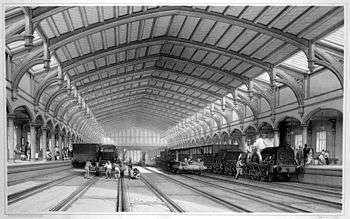
The original terminus was built in 1839–41 for the Great Western Railway (GWR), the first passenger railway in Bristol, and was designed by Isambard Kingdom Brunel, the railway's engineer.[4] It was built to Brunel's 7 ft (2,134 mm) broad gauge. The station was on a viaduct to raise it above the level of the Floating Harbour and River Avon, the latter being crossed via the grade I listed Avon Bridge. The station was covered by a 200-foot (60 m) train shed, extended beyond the platforms by 155 feet (47 m) into a storage area and engine shed, fronted by an office building in the Tudor style.[5] Train services to Bath commenced on 31 August 1840 and were extended to Paddington on 30 June 1841 following the completion of Box Tunnel.[6]
.jpg)
A few weeks before the start of the services to Paddington the Bristol and Exeter Railway (B&ER) had opened, on 14 June 1841,[7] its trains reversing in and out of the GWR station. The third railway at Temple Meads was the Bristol and Gloucester Railway, which opened on 8 July 1844 and was taken over by the Midland Railway (MR) on 1 July 1845.[6] This used the GWR platforms, diverging onto its own line on the far side of the bridge over the Floating Harbour. Both these new railways were engineered by Brunel and were initially broad gauge.[7] Brunel also designed the Bristol and South Wales Union Railway, but this was not opened until 25 August 1863, nearly four years after his death. It terminated at Temple Meads.
| Wikimedia Commons has media related to Brunel's Temple Meads railway station. |
Bristol and Exeter Railway station

In 1845 the B&ER built its own station at right angles to the GWR station and an "express platform" on the curve linking the two lines so that through trains no longer had to reverse. The wooden B&ER station was known locally as "The Cowshed";[5] but a grand headquarters was built at street level on the west side of its station in 1852–54 to the Jacobean designs of Samuel Fripp.[4] The Bristol and Portishead Pier and Railway opened a branch off the Bristol and Exeter line west of the city on 18 April 1867, the trains being operated by the B&ER and using its platforms at Temple Meads.[8]
In 1850 an engine shed had been opened on the south bank of the River Avon on the east side of the line to the B&ER station.[9] Between 1859 and 1875, 23 engines were built in the workshops attached to the shed, including several distinctive Bristol and Exeter Railway 4-2-4T locomotives.[10]
Goods stations
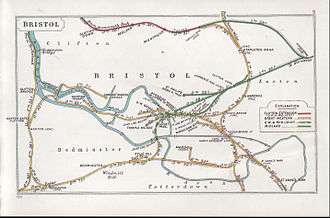
The GWR built a 326-by-138-foot (99 m × 42 m) goods shed on the north side of the station adjacent to the Floating Harbour, with a small dock for transhipment of goods to barges (not seagoing ships, as the wharf was upstream of Bristol Bridge). Wagons had to be lowered 12 feet (4 m) to the goods shed on hoists. On 11 March 1872, a direct connection to the harbour was made in the form of the Bristol Harbour Railway, a joint operation of the three railways, which ran between the passenger station and the goods yard, across the street outside on a bridge, and descended into a tunnel under the churchyard of St. Mary Redcliffe on its way to a wharf downstream of Bristol Bridge.[5]
The B&ER had a goods depot at Pylle Hill (south of the station) from 1850, and the MR had an independent yard at Avonside Wharf on the opposite side of the Floating Harbour from 1858.[11]
Effects of the change of gauge
On 29 May 1854 the Midland Railway laid a third rail along their line to Gloucester to provide mixed gauge so that it could operate 4 ft 8 1⁄2 in (1,435 mm) standard gauge passenger trains while broad gauge goods trains could still run to collieries north of Bristol. Sidings at South Wales Junction allowed traffic to be transhipped between wagons on the two different gauges. The GWR continued to operate its trains on the broad gauge,[6] but on 3 September 1873 it opened the standard gauge Bristol and North Somerset Railway. This had a junction nearly 1⁄2 mile (800 m) from the station on the London line and so mixed gauge was extended to that point. During the following year mixed gauge track was continued beyond Bath in connection with the conversion of the Wilts, Somerset and Weymouth Railway to standard gauge. Mixed gauge was laid through Box Tunnel on 16 May 1875 and so standard gauge trains could run to London, although broad gauge was retained west of Temple Meads and through trains from London to Penzance and other stations in Devon and Cornwall continued to be broad gauge.[7] Goods traffic was transhipped between the two gauges in the B&ER yard at Pylle Hill.
The B&ER converted the line to Taunton to mixed gauge by 1 June 1875, but the remainder of the line to Exeter was not done until 1 March 1876, three months after the B&ER had amalgamated with the GWR. The remainder of the lines beyond Exeter were converted to standard gauge on 21 May 1892[7] so the extra rails at Temple Meads fell into disuse and were removed to leave a purely standard gauge layout. This allowed the through station to be rebuilt with two additional platform faces.[5]
1870s expansion
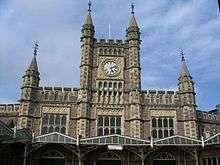
The additional railway routes put the two short 140-yard (130 m) platforms of Brunel's terminus under pressure and a scheme was developed to extend the station. An enabling Act of Parliament was passed in 1865 and between 1871 and 1878 the station was extensively rebuilt. Brunel's platforms were extended by 212 yards (194 m) towards London and a new three-platform through station built on the site of the express platform, while the B&ER station was closed and the site used for a new carriage shed.[12] This work is usually attributed to Brunel's former associate Matthew Digby Wyatt, but there is no documentary evidence of his involvement in the Minutes of the Station Joint Committee. The only signature on the drawings is that of Francis Fox, the engineer of the B&ER.[13] The curved wrought-iron train shed over the new through platforms was 500 feet (150 m) long on the platform wall. The goods depot was rebuilt with the inconvenient wagon hoists replaced by a steep incline from the east end of Temple Meads, which meant that the sidings in the goods shed were at right angles to their original alignment and the barge dock was filled in.[11]
Trains on the Bristol and South Wales Union and the Midland routes operated from the terminal platforms while the GWR used the new through platforms.[5] The capital costs of the new work were split 4/14 GWR/B&ER and 10/14 MR, operating costs were split GWR 3/8, MR 3/8 and B&ER 2/8. Hence when the GWR absorbed the B&ER in 1876 the split was GWR 5/8 and MR (later LMS) 3/8, until nationalisation on 1 January 1948.[13]
Twentieth century changes
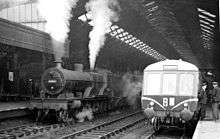

In 1924 the goods depot was rebuilt with 15 platforms, each 575 feet (175 m) long. Large warehousing and cellar space was provided to store goods, although by this time another city centre goods depot had been opened at Canons Marsh.[11]
Between 1930 and 1935 the through station was expanded under the direction of the GWR's chief architect P E Culverhouse, in art deco style, both eastwards over the old cattle market and southwards on a new wider bridge across Cattle Market Road and the New Cut of the River Avon. This made room for the addition of five through-platform faces, while the removal of the narrow island platforms in the middle of the train shed allowed the main Up and Down platforms to be both widened and lengthened.[12] All the routes approaching Temple Meads were widened to four tracks to allow more flexibility.[11]
As part of this work four manual signal boxes were replaced by three power signal boxes, and the semaphore signals and mechanical point linkages were replaced by colour light signals and point motors. The new Bristol Temple Meads East box was the largest on the GWR with 368 miniature levers operated by three signalmen assisted by a "booking boy". The other two boxes were at Bristol Temple Meads West, and controlling the movements in and out of the new Bath Road Depot, which replaced the old B&ER locomotive works in 1934.[11]
During World War II the station was bombed, which led to the destruction of the wooden spire of the clock tower above the ticket office on 3 January 1941.[12] Gas lighting was replaced by fluorescent electric lights in 1960.[11]
Bristol Panel Signal Box was built on the site of the Platform 14. When opened it controlled 280 multiple-aspect signals and 243 motor-worked points on 114 miles (183 km) of route, the largest area controlled by a single signal box on British Rail at the time.[14]
The construction of this signal box, completed in 1970, involved the demolition of almost half of the 1870s extension to Brunel's terminus and completely blocked rail access to the Old Station [15]
A second main-line station serving the city, Bristol Parkway, opened in 1972. It is on the northern outskirts of the conurbation close to the M32 motorway and was designed as a park and ride facility for long-distance travellers.[16]
In the late 1960s the Royal Mail built a mail conveyor at the northern end of the station, with significant aesthetic impact. This was out of use for many years following the transfer of Royal Mail's activities to the West of England Mail Centre at Filton and the opening of the short-lived Railnet Hub next to Bristol Parkway station in May 2000.[17] It was finally dismantled in stages and removed between October and December 2014.[18] In 1990/91, £2 million was spent by InterCity on a renovation of the main train shed and another £7 million on restoring some of the older areas of the station, including the refurbishment of the subway and construction of new retail outlets. The shorter of the two 1935 platform islands had been used only for parcels traffic since the 1960s but was temporarily brought back into passenger use during this work. It was fully restored for passenger use in 2001.[12]
In August 1998, a 15-month, £7 million project commenced with work performed on the external facade, clocktower, roof and paving.[19][20] As part of this work, the original quarry from which the dolomite stone had originally been extracted was reopened in Abbots Leigh.[21]
| Preceding station | Historical railways | Following station | ||
|---|---|---|---|---|
| St Anne's Park | Great Western Railway To London via Box |
Bedminster | ||
| Lawrence Hill | Great Western Railway To London via Badminton, To Cardiff and Pilning via Avonmouth |
|||
| Brislington | Great Western Railway To Radstock |
Terminus | ||
| Fishponds | Bristol and Gloucester Railway (later Midland Railway) |
Terminus | ||
Closure of lines
Passenger traffic on the old North Somerset line ceased on 2 November 1959 and many more closures followed after the publication of Dr Beeching's The Reshaping of British Railways in 1963. The connection to the Bristol Harbour Railway was closed on 6 January 1964; passenger trains to Portishead were withdrawn on 7 September 1964; and most local services in the north of the city were withdrawn on 23 November 1964. The following year saw local services on the Midland route to Gloucester withdrawn[22] and the Midland route to Bath Green Park via Mangotsfield was closed on 7 March 1966. St Anne's Park and Saltford on the line towards Bath survived until 5 January 1970.[22]
On 12 September 1965 the terminal platforms were closed. This allowed the platforms to be renumbered with the order reversed (see list below).[11] The redundant train shed became a covered car park in February the following year, but from 1989 until 1999 the original (Brunel) part was an interactive science centre known as The Exploratory and an exhibition space. From 2002 to 2008 it housed the British Empire and Commonwealth Museum.[23] As of 2016 the shed, now known as the Passenger Shed, is a venue for events such as conferences and weddings.[24]
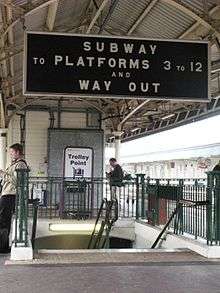

| Old | New | Location |
|---|---|---|
| 1 | 15 | |
| 2 | 13 | |
| 3 | 12 | West end |
| 4 | 11 | East end |
| 5 | 9 & 10 | East and west ends numbered differently |
| 6 | 7 & 8 | East and west ends numbered differently |
| 7 | 5 | East end in the main train shed |
| 8 | 6 | West end beyond (new ) platform 5 |
| 9 | 3 | East end in the main train shed |
| 10 | 4 | West end beyond (new) platform 3 |
| 11 | 2 | West end bay |
| 12 | 1 | East end of arrival platform |
| 13 | Closed | West end of arrival platform |
| 14 | Closed | East end of departure platform |
| 15 | Closed | West end of departure platform |
Enterprise zone and station redevelopment
Bristol Temple Quarter Enterprise Zone, an enterprise zone with an area of 70 hectares (170 acres) centred on Temple Meads,[25] was announced in 2011,[26] and launched in 2012. Network Rail is a partner in coordinating development in the zone.[25] In November 2012, Network Rail announced a £100 million redevelopment of the station, with two unused platforms to be opened up. Station Approach Road will be turned into a public square and the station's main entrance moved to the north side.[27] A large bridge above the tracks at the east end of the station which was erected in the 1970s for postal traffic was demolished at Christmas 2014.[28] In November 2016, the University of Bristol announced that it plans to build a Temple Quarter Campus to the east of the station, replacing the derelict sorting office which was formerly connected to the station by the bridge.[29]
Bristol and Exeter House has been redeveloped by TCN UK as a business hub for small and medium-sized enterprises. Part of Brunel's station has found a new use in a redevelopment by the City Council, the University of Bristol and the West of England Local Enterprise Partnership.[25] Opened in 2013 as the Engine Shed,[26] it hosts business incubators for startups.[30]
To the south of the station, the former site of the Bristol Bath Road Traction Maintenance Depot is being redeveloped into the 12,000-capacity Bristol Arena.[31]
Description

Approaches
.jpg)
Although it is now possible to reach the station through the Temple Quay office development (on the site of the goods shed) or from the Bristol Ferry Boat Company landing stage on the Floating Harbour, the traditional and main approach is from Temple Gate. Isambard Kingdom Brunel's Tudor-style offices, later used by the former British Empire and Commonwealth Museum, face this road and are flanked on the north side by an archway that used to be the main station for departing passengers; a matching arch on the other side was the arrivals gateway but was removed when the station was expanded in the 1870s.[5]
Opposite these offices are the Grosvenor Hotel and the derelict George Railway Hotel, which were built in the 1870s,[4] on either side of the site of the Bristol Harbour Railway bridge. A modern pub named The Reckless Engineer as a tribute to Brunel faces the approach road to the station.
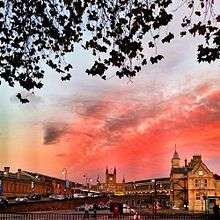
On the right of the Station Approach but at a lower level is the B&ER office building designed by Samuel Fripp; the 1930s offices known as "Collett House" (named after Charles Collett) and a disused parcels depot lie beyond. On the left is Brunel's original station building. The train shed is 72 feet (22 m) wide with a wooden box-frame roof and cast iron columns disguised as hammerbeams above Tudor arches. It is believed to be the widest hammerbeam roof in England and, along with most of the station, is a Grade 1 listed building,[32][33] and forms part of a proposed Great Western Railway World Heritage Site.[34] At the top of the slope an entrance on the left to the covered car park marks the junction between the original terminus and Fox's 1870s extension.
Ahead is the turreted main station building, and to the right a flat area marks the site of the B&ER station. The tunnel beneath this area was the route for passengers to and from the Down platform from 1878 until the station was enlarged in 1935.[12]
Station
Entering the main building, the ticket office and ticket machines are immediately ahead, and the route from Temple Quay and the ferry is on the left; a bookshop is on the right, next to the platform entrance. Customer Information System screens by the entrance show arrival and departure information for all platforms, as do displays on each of the platforms. All platforms are signalled for trains in either direction and the flexible layout means that trains on any route can use any part of the station.[35] Platforms with odd numbers are at the east end, even numbers at the west end (geographically the south, due to the curvature of the platforms).[36]
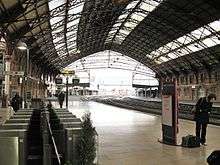
Entrance to the platforms is controlled by automatic ticket gates on Platform 3, which is used by many northbound CrossCountry trains and local services to Bristol Parkway and Gloucester. The main station restaurant and bar is on the left[37] and the short Platform 1, a bay, is beyond this. This is most frequently used by Severn Beach Line trains but is long enough to handle any four-car Diesel Multiple Unit (DMU). Behind Platform 1 is a brick wall that forms part of the signal box and on this are some metal artworks created by artists with learning difficulties to celebrate Brunel's 200th anniversary in 2006; an interpretation panel is nearby. The High Level Siding beyond Platform 1 is the rump of the Bristol Harbour Railway, and Barton Hill traction maintenance depot can be seen in the distance alongside Bristol East Junction (formerly South Wales Junction) where the lines to Bristol Parkway and Bath diverge.
On the right of the entrance is the subway that links all the platforms, reached either by steps or lift;[37] it houses the main public toilets, automated teller machines (ATM) and several catering outlets (there is catering on all platform islands except 13–15). A passenger information office and lounge are above the subway, the British Transport Police office and cycle racks are beyond,[37] and at the western end is Platform 4, used by only a few trains. Alongside this is Platform 2, another bay platform but not signalled for passenger trains and used only for stabling empty trains, as is the former Motorail unloading bay alongside. At the far end of this track is the old Fish Dock, occasionally used for stabling engineers' on-track equipment. Beyond the end of the platform the tracks swing to the right (the west) and pass out of sight beneath Bath Road Bridge, a girder bridge that carries the A4 out of the city.
The first island platform comprises platforms 5 to 8. Platform 5 is inside the main train shed while 6 is a southerly extension and 7 and 8 were added outside the supporting wall in the 1930s.[12] Platform 5 is used by trains towards Cardiff and platform 7 to Portsmouth; platforms 6 and 8 are the main platforms for Weston-super-Mare and stations to Penzance. Between platforms 5 and 7 are the two spur sidings that are long enough to stable a single Class 153 DMU.
The third island platform comprises platforms 9 to 12 and also dates from the 1930s.[12] It is longer than platforms 5–8 but the rear of a High Speed Train on the west end platforms will block part of the east end platform.[36] A wide variety of trains use these platforms, including to and from London Paddington and London Waterloo and Weymouth.
The final island platform is shorter and only has east-end platforms 13 and 15: 15 is used by most trains from Paddington that continue westwards to Weston-super-Mare or beyond. Platform 13 is a terminus platform and is used by many trains from Paddington, some local services and occasionally by CrossCountry. There is another siding beyond platform 15 that used to be the In/Out Road for Bath Road Traction Maintenance Depot. This depot has been demolished. Between platforms 3/4 and 5/6 are the Up Through line and the Middle Siding, the latter is often used to stable Mark 1 carriages between Torbay Express duties in the summer months. The Down Through line runs between platforms 11/12 and 13.[36]
To the north of the station lies Arriva TrainCare's Barton Hill train maintenance depot that services Class 220/221 Voyagers for CrossCountry Class 66 locomotives for DB Schenker and during summer months steam locomotives operating the Torbay Express. To the south-east of the station lies St Philip's Marsh depot that services the Great Western Railway fleet. This is accessible from both ends of Temple Meads station.
Other facilities include pay phones, public Wi-Fi, a post box, photo booth, and passenger assistance such as information points, waiting rooms, a lost property office, first aid room, and CCTV.[37]
Passenger volume
Temple Meads is the busiest station in the Bristol area. Official statistics show it to have the 35th-largest number of people entering or leaving any national rail station, the 14th busiest outside London. Comparing the year from April 2009 with the year from April 2002, estimated passenger numbers increased by 52%.[note 1]
| 2002–03 | 2004–05 | 2005–06 | 2006–07 | 2007–08 | 2008–09 | 2009–10 | 2010–11 | 2011–12 | 2012–13 | 2013–14 | |
|---|---|---|---|---|---|---|---|---|---|---|---|
| Entries | 2,590,543 | 2,823,258 | 3,039,104 | 3,279,898 | 3,541,946 | 3,914,814 | 3,937,843 | 4,204,670 | 4,442,313 | 4,549,684 | 4,761,420 |
| Exits | 2,586,575 | 2,818,114 | 3,027,136 | 3,268,961 | 3,540,152 | 3,914,814 | 3,937,843 | 4,204,670 | 4,442,313 | 4,549,684 | 4,761,420 |
| Interchanges | unknown | 798,961 | 856,644 | 917,595 | 845,178 | 890,706 | 979,955 | 1,107,555 | 1,327,179 | 1,386,664 | 1,434,465 |
| Total | 5,177,118 | 6,440,333 | 6,922,883 | 7,466,454 | 7,927,276 | 8,720,334 | 8,855,641 | 9,516,895 | 10,211,805 | 10,486,032 | 10,957,305 |
The statistics cover twelve-month periods that start in April.
Services
Rail
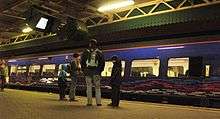
The station is operated by Great Western Railway, along with main line services to London Paddington station,[39] long distance services to Cardiff Central[40] and the South Coast,[41] local services to Weston-super-Mare, Taunton and Gloucester and a few services each day to/from Brighton.[42]
An alternative route, to London Waterloo, is provided by South West Trains,[43] while regular CrossCountry services run south to Paignton, Plymouth and Penzance,[44] and north to Manchester, Leeds, Edinburgh, Glasgow and Aberdeen.[45]
Bus
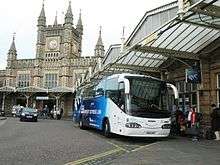
Temple Meads is served by many buses operated by First Bristol including:
- A1: to Bristol Airport[46]
- 1: to Broomhill and Cribbs Causeway[47]
- 2: to Stockwood and Cribbs Causeway[48]
- 8, 9: circular routes to Clifton and Redland[49]
- 11: to University of the West of England, Frenchay and Bower Ashton campuses[50]
- 38/39/349/X39: to Bath via Keynsham (38/39/349), Saltford[51]
- 70: to University of the West of England, Frenchay[52]
- 73: to Cribbs Causeway via City Centre, Filton, Bradley Stoke, Patchway[53]
- 178: Radstock via Keynsham[54]
- 376: to Street via Wells[55]
Wessex Bus operate two routes via Temple Meads station:
Ferry
Harbour ferry services, operated by Bristol Ferry Boats and Number Seven Boat Trips, call at a landing stage in the Floating Harbour outside the station. The service links Bristol Bridge, St Augustine's Reach in the City Centre, the SS Great Britain, and Hotwells.[57]
Future
First Great Western exercised a break clause in the Greater Western franchise thus avoiding large premium payments to the Department for Transport.[58][59][60] With the franchise to now conclude in March 2013, it was put out to tender,[61][62][63] but the process was scrapped as part of the fallout from the collapse of the InterCity West Coast franchise competition.[64]
Subsequently a new contract until September 2015 was negotiated between First Great Western and the Department for Transport[65][66] and subsequently extended until March 2019.[67][68][69] The coming years will see the High Speed Trains replaced with new Class 800/801 Intercity Express Trains, capacity enhancements and smart ticketing.[70]
The Great Western Main Line from London to Bristol is in the process of being electrified.[71] However because of cost overruns and delays, on 8 November 2016 the government announced that several elements of the programme would be deferred including electrification south west of Thingley Junction near Chippenham and Bristol Parkway. This will leave Temple Meads un-electrified but the new Hitachi Super Express trains are bi-mode so can operate as diesels around Bristol and can use electricity where the electrification work is complete.[72][73] The electrification plans do not extend west of Bristol so local services will continue to be provided using diesel trains, with Class 165/166s cascaded from Thames Valley services scheduled to replace the 150/153/158s on local services.[74][75]
The Portishead Branch Line, which runs along the south side of the River Avon from a junction just beyond Parson Street is proposed to be reopened.[76] There is an aspiration of two trains per hour between Portishead and Temple Meads in peak periods, possibly calling at Bedminster and Parson Street.[77][78][79][80][81] The line was built in the 1860s, but closed to passenger traffic in 1964, leaving Portishead as one of Britain's largest towns without a railway station. The line was reopened for freight traffic to serve Royal Portbury Docks in 2001, and the restoration of passenger traffic is considered part of the Greater Bristol Metro scheme, which was given the go-ahead in July 2012 as part of the City Deal, whereby local councils would be given greater control over money by the government.[76]
The Metro scheme could also see the reopening of the Henbury Loop Line to passengers, with the possibility of services from Temple Meads to Bristol Parkway via Clifton Down and Henbury.[76] Plans for a loop were rejected by the West of England Joint Transport Board, however in July 2015 Bristol City Councillors voted to send the decision back to the board for further discussion.[82][83]
The station roof is to be refurbished as part of a scheme to transform the station over the next 25 years.[84] On 1 April 2014, Network Rail took over management of the station from First Great Western.[1][85]
See also
Notes
- ↑ Annual estimated passenger usage based on sales of tickets in stated financial year(s) which end or originate at Patchway, from Office of Rail and Road statistics.[38] Methodology may vary year on year.
References
- 1 2 "Two more stations for NR" Today's Railways issue 150 June 2014 page 13
- ↑ "Temple Church". Images of England. Retrieved 2006-07-28.
- ↑ Lobel, MD (1975). The Atlas of Historic Towns, Volume 2: Bristol, Cambridge, Coventry, Norwich. London: The Scolar Press in conjunction with The Historic Towns Trust. ISBN 0-85967-185-2.
- 1 2 3 Foyle, Andrew (2004). Pevsner Architectural Guides: Bristol. New Haven and London: Yale University Press. ISBN 0-300-10442-1.
- 1 2 3 4 5 6 Binding, John (2001). Brunel's Bristol Temple Meads. Hersham: Oxford Publishing Company. ISBN 0-86093-563-9.
- 1 2 3 MacDermot, E T (1927). History of the Great Western Railway, volume I 1833–1863. London: Great Western Railway.
- 1 2 3 4 MacDermot, E T (1931). History of the Great Western Railway, volume II 1863–1921. London: Great Western Railway.
- ↑ Awdry, Christopher (1990). Encyclopaedia of British Railway Companies. Sparkford: Patrick Stephens Ltd. ISBN 1-8526-0049-7. OCLC 19514063., P 19.
- ↑ Lyons, E; Mountford, E (1979). Great Western Engine Sheds 1837–1947. Poole: Oxford Publishing Company. ISBN 0-86093-019-X.
- ↑ Reed, P.J.T. (February 1953). White, D.E., ed. The Locomotives of the Great Western Railway, Part 2: Broad Gauge. Kenilworth: The Railway Correspondence and Travel Society. ISBN 0-901115-32-0. OCLC 650490992.
- 1 2 3 4 5 6 7 Maggs, Colin (1981). Rail Centres: Bristol. Shepperton: Ian Allan. ISBN 0-7110-1153-2.
- 1 2 3 4 5 6 7 Oakley, Mike (2002). Bristol Railway Stations 1840–2005. Wimbourne: The Dovecote Press. ISBN 1-904349-09-9.
- 1 2 Nichols, Gerry (2005). "Rebuilding Temple Meads Passenger Station 1870 to 1875". Broadsheet. Broad Gauge Society (54): 8–15.
- ↑ Kichenside, GM (1973). "The Bristol resignalling scheme controls the crossroads of the West". Modern Railways. Ian Allan. 30 (292): 10–15.
- ↑ "Bristol Powerbox". Bristol Railway Archive. Retrieved 2012-04-08.
- ↑ Butt, R. V. J. (1995). The Directory of Railway Stations: details every public and private passenger station, halt, platform and stopping place, past and present (1st ed.). Sparkford: Patrick Stephens Ltd. ISBN 1-8526-0508-1. OCLC 60251199.
- ↑ "Royal Mail terminal opens at Bristol Parkway" Rail issue 384 31 May 2000 page 7
- ↑ "Regional News" Rail issue 776 10 June 2015 page 18
- ↑ "Temple Meads loses out as work starts on new Parkway mail centre" Rail issue 334 1 July 1998 page 16
- ↑ "New look for Temple Meads" Rail issue 338 26 August 1998 page 14
- ↑ "Railtrack gets Bristol quarry site approval" Rail issue 347 30 December 1998 page 12
- 1 2 prepared by the County Planning Department (1983). Railways in Avon, a short history of their development and decline 1832 – 1982. Bristol: Avon County Planning Department. ISBN 0-86063-184-2.
- ↑ "News". British Empire and Commonwealth Museum. Retrieved 2007-03-13.
- ↑ "Brunel's Old Station". www.brunels-old-station.co.uk. Retrieved 8 August 2016.
- 1 2 3 "An enterprising idea with a radically new approach". Bristol Post. 8 July 2013. Retrieved 18 March 2015.
- 1 2 "Bristol enterprise zone looks to keep up the momentum". Bristol Post. 16 April 2014. Retrieved 18 March 2015.
- ↑ "Bristol Temple Meads station to get £100m investment". BBC News Online. 14 November 2012. Retrieved 18 March 2015.
- ↑ "The removal of the conveyor belt at Bristol Temple Meads station timelapse". YouTube. Network Rail. Retrieved 2015-06-12.
- ↑ Yong, Michael (29 November 2016). "Bristol University to take over old sorting office by Temple Meads for new £300m campus". Bristol Post. Retrieved 29 November 2016.
- ↑ "Why tech industries are thriving in the south-west of England". The Guardian. 10 February 2014. Retrieved 18 March 2015.
- ↑ "Council handed land for Bristol Arena by the government". BBC News Online. 27 March 2015. Retrieved 29 November 2016.
- ↑ "Bristol Old Station, Temple Meads". Images of England. Retrieved 2007-03-13.
- ↑ "Temple Meads Station". Images of England. Retrieved 2007-03-16.
- ↑ "The Great Western Railway: Paddington-Bristol (selected parts)". United Nations Educational, Scientific and Cultural Organisation. 1999. Retrieved 22 May 2008.
- ↑ "BRI Network Rail Live Departures and Arrivals". National Rail Enquiries. Retrieved 2008-07-04.
- 1 2 3 Jacobs, Gerald (2005). Railway Track Diagrams Book 3: Western. Bradford-on-Avon: Trackmaps. ISBN 0-9549866-1-X.
- 1 2 3 4 "Station Facilities: Bristol Temple Meads". National Rail Enquiries. Retrieved 2008-07-04.
- ↑ "Estimates of station usage". Office of Rail and Road. Retrieved 19 October 2015.
- ↑ "National Rail Timetable 125 (Summer 2008)" (PDF). Network Rail.
- ↑ "National Rail Timetable 132 (Summer 2008)" (PDF). Network Rail.
- ↑ "National Rail Timetable 123 (Summer 2008)" (PDF). Network Rail.
- ↑ "National Rail Timetable 134 (Summer 2008)" (PDF). Network Rail.
- ↑ "National Rail Timetable 160 (Summer 2008)" (PDF). Network Rail.
- ↑ "National Rail Timetable 135 (Summer 2008)" (PDF). Network Rail.
- ↑ "National Rail Timetable 51 (Summer 2008)" (PDF). Network Rail.
- ↑ "Timetables (To Bristol Airport)". Bristol Airport. Retrieved 8 May 2013.
- ↑ "1" (PDF). First Group.
- ↑ "51" (PDF). First Group. Retrieved 15 October 2015.
- ↑ "8/9" (PDF). First Group. Retrieved 15 October 2015.
- ↑ "11 UWE Frenchay Campus - Bower Ashton". Traveline South West. Retrieved 8 May 2013.
- ↑ "X39/338/339" (PDF).
- ↑ "70" (PDF). First Group. Retrieved 15 October 2015.
- ↑ "73" (PDF). FirstGroup. Retrieved 10 November 2016.
- ↑ "178" (PDF).
- ↑ "X75/375/376/377" (PDF). First Group. Retrieved 15 October 2015.
- ↑ Route 506 timetable Wessex Bus
- ↑ "Timetables". Bristol Ferry Boats. Retrieved 8 May 2013.
- ↑ "First Great Western bids for longer rail franchise deal". BBC News. 11 May 2011. Retrieved 27 April 2012.
- ↑ "First rejects Great Western extension but plans new bid" Rail issue 670 18 May 2011 page 6
- ↑ "FGW opts out of Great Western extension" Modern Railways issue 753 June 2011 page 7
- ↑ Haigh, Philip (18 April 2012). "First leads a field of seven bidding for rail franchises". RAIL magazine. Peterborough: Bauer Media (694): 8–9.
- ↑ "Great Western franchise to be extended". Railnews. 19 July 2012. Retrieved 19 July 2012.
- ↑ "New Great Western franchise to deliver new express trains" (Press release). Department for Transport. 27 July 2012. Retrieved 29 July 2012.
- ↑ "Great Western London to south Wales rail contest scrapped". BBC News. BBC. 31 January 2013. Retrieved 31 January 2013.
- ↑ "First celebrates last-minute Great Western deal". Railnews. 3 October 2013. Retrieved 4 October 2013.
- ↑ "First Great Western retains Wales and west rail franchise". BBC News. BBC. 3 October 2013. Retrieved 4 October 2013.
- ↑ "First Great Western offered new franchise deal". BBC News. BBC. 10 October 2014. Retrieved 10 October 2014.
- ↑ "FirstGroup wins Great Western contract extension". The Guardian. Guardian Media Group. 10 October 2014. Retrieved 10 October 2014.
- ↑ "Updated franchise schedule signals GW extension". Railnews. 10 October 2014. Retrieved 10 October 2014.
- ↑ "Weston-super-Mare to London rail re-franchise concerns". BBC News. BBC. 10 August 2012. Retrieved 13 August 2012.
- ↑ "Modernising the Great Western" (PDF). Network Rail. Retrieved 9 June 2012.
- ↑ "Great Western electrification: Intercity line work 'deferred'". BBC News. 8 November 2016. Retrieved 10 November 2016.
- ↑ Paul Maynard (8 November 2016). "Written statement to Parliament, Rail update: rail investment in the Great Western route". gov.uk. Retrieved 8 November 2016.
- ↑ "Bristol to London line to be electrified". This is Bristol. Northcliffe Media. 23 July 2009. Retrieved 5 April 2012.
- ↑ Clinnick, Richard (15 April 2015). "How the West will win with new trains". RAIL magazine. Peterborough: Bauer Media (772): 58–59. Retrieved 12 October 2015.
- 1 2 3 Ribbeck, Michael (6 July 2012). "£100 million Bristol Metro train network by 2016". The Post, Bristol. Northcliffe Media. Retrieved 6 July 2012.
- ↑ Bristol Evening Post (18 June 2011). "New fight launched to reopen railway line". This is Bristol. Northcliffe Media. Retrieved 8 May 2012.
The aspiration is for a regular service on a reopened line with new stations at Ashton Gate, Pill and Portishead and stopping trains at Parson St and Bedminster.
- ↑ Network Rail (March 2010). "Great Western Route Utilisation Strategy" (PDF). pp. 41, 51, 60, 63, 128, 165, 210, 211. Retrieved 20 May 2012.
- ↑ "Portishead rail link plan is latest in long-running saga". This is Bristol. Northcliffe Media. 20 August 2008. Retrieved 8 May 2012.
The most expensive option would see two trains an hour on the line at peak times and one in less busy periods, with trains calling at Pill, Ashton Gate, Bedminster and Parson Street, a passing loop and additional signals.
- ↑ Broadbent, Steve (16 May 2012). "Ship-shape and Bristol fashion". RAIL magazine. Peterborough: Bauer Media (696): 46–53.
- ↑ "Portishead rail link signals are encouraging, says North Somerset MP Liam Fox". Western Daily Press. Northcliffe Media. 19 December 2011. Retrieved 28 December 2011.
- ↑ "Transport chiefs drop Henbury Loop plan". BBC News. BBC. 17 July 2015. Retrieved 16 September 2015.
- ↑ "Huge majority back rethink on decision for Henbury Loop at a special meeting". Bristol Post. Local World. 28 August 2015. Retrieved 16 September 2015.
- ↑ "Bristol Temple Meads station roof to be replaced". BBC News. BBC. 17 October 2013. Retrieved 19 October 2013.
- ↑ "Reading railway station to be managed by Network Rail". BBC News. BBC. 18 November 2013. Retrieved 26 November 2013.
Further reading
- Buchanan, RA; Williams, M (1982). Brunel's Bristol. Bristol: Redcliffe Press. ISBN 0-905459-39-3.
- Gomme, A; Jenner, M; Little, B (1979). Bristol: an Architectural History. London: Lund Humphries. ISBN 0-85331-409-8.
- Harris, Peter (1987). Bristol's Railway Mania 1862–1864. Bristol: Bristol Branch of the Historical Association. ISBN 0-901388-49-1.
- Jowett, Alan (1993). Jowett's Atlas of Railway Centres: of Great Britain showing their development from the earliest times up to and including the 1990s - Volume 1 (1st ed.). Sparkford: Patrick Stephens Ltd. ISBN 1-8526-0420-4. OCLC 30919645.
External links
| Wikimedia Commons has media related to Bristol Temple Meads railway station. |
- Detailed historic record for Bristol Temple Meads railway station, English Heritage
- Bristol Temple Meads Station (excerpts from original plans), Network Rail Archive
- Panoramic photograph inside the train shed
- Photographs of Bristol Temple Meads
.jpg)
